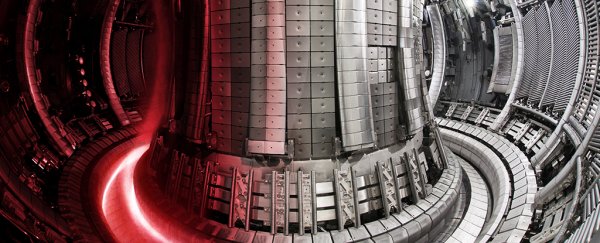Late last century, the Joint European Torus (JET) near Oxford, UK, churned out 22 megajoules of energy in what was, at the time, a record in fusion power.
Now, experimental upgrades have brought the facility into line with the technology anticipated for a major international project, resulting in the production of nearly three times that amount of power.
The advances are a major step forward for tokamak-based fusion, bringing us ever closer to a balance point where we can harvest a near endless stream of energy without the cost of polluting emissions or large amounts of radioactive waste.
"What we have learned in the past months will make it easier for us to plan experiments with fusion plasmas that generate much more energy than is needed to heat them," says Sibylle Günter, the Scientific Director of the Max Planck Institute for Plasma Physics.
Tokamaks might be the horse to back for reaching this milestone in energy production. Consisting of a relatively simple torus surrounded by a bank of seriously powerful magnets, they facilitate fusion by channeling bursts of hydrogen heated to dissolve into a plasma.
What might sound relatively straight forward though is anything but. Keeping that churning stream of plasma stable long enough to squeeze out enough energy-carrying neutrons requires a lot of fine-tuning in technology.
As part of Europe's 'road map to fusion', projects like JET play a key role in breaking down this litany of obstacles. Though the big game is still yet to come.
An international collaboration called ITER is building the largest tokamak the world has ever seen in southern France – one that could eventually generate a whopping 500 megawatts of power from a mere 50 megawatts of initial heating.
Most research on fusion currently uses common forms of hydrogen with either a single proton in its nucleus (called protium), or a slightly rarer form with a proton and a neutron (called deuterium).
This is good enough to iron out the wrinkles until we've got fusion all worked out. But to really get a bang from our fusion reactor, we'll want an even scarcer resource carrying one more neutron – a form of hydrogen called tritium.
ITER aims to experiment with combinations of tritium and deuterium by 2035, and hopefully achieve self-sustaining plasma reactions that will release more energy than they consume.
It's a lofty goal that will depend on a little guidance from smaller projects like JET.
JET stands out as a tokamak capable of using both of these materials, allowing researchers to get a good start on understanding their unique nuclear characteristics.
In 1997, the project hit a record in energy output in the form of released neutrons, providing the equivalent of 4.4 megawatts of power over an average of 5 seconds.
Since then they've been tinkering with designs, including the replacement of the carbon lining, with a mixture of tungsten and beryllium. While the new material is more resilient and won't act like a hydrogen sponge in ways that carbon can, it does affect the plasma's movement.
Finally, after a great deal of modeling, experiments have confirmed predictions of new limits on energy production from this powerful duo of hydrogen isotopes, breaking the old record with an output of 59 megajoules.
It's still short of anything that can perpetuate ongoing fusion, let alone release more energy than it requires. For that, we'll need something much larger, but it's a significant achievement nonetheless.
"In the latest experiments, we wanted to prove that we could create significantly more energy even under ITER-like conditions," says physicist Athina Kappatou from the Max Planck Institute for Plasma Physics.
Once energy production is in the black, a surplus of neutrons released from the tokamak's churning loop of plasma can be directed onto a thin layer of lithium, which through nuclear fission will break down to provide a more ready source of tritium.
In theory it all sounds so simple. But if we've learned anything from studying fusion, harnessing the Sun's own blueprints for energy generation is anything but a smooth ride.
Thankfully facilities around the world are gradually finding ways around the numerous problems, raising temperatures and working out how to sustain longer reaction times.
Together, we just might yet get the clean, virtually unlimited power source we so desperately need.
